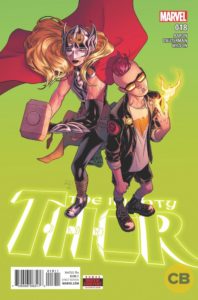 The Mighty Thor #18 — Writer: Jason Aaron; Art: Russell Dauterman; Colors: Matthew Wilson
The Mighty Thor #18 — Writer: Jason Aaron; Art: Russell Dauterman; Colors: Matthew Wilson
Moon Girl and Devil Dinosaur #18 — Writers: Brandon Montclare and Amy Reeder; Art: Natacha Bustos; Colors: Tamra Bonvillain
Patsy Walker, A.K.A. Hellcat #17 — Writer: Kate Leth; Art: Brittney L. Williams; Colors: Rachelle Rosenberg
Hulk #5 — Writer: Mariko Tamaki; Art: Nico Leon; Colors: Matt Milla and Andrew Crossley
Of the books spotlighting women characters this week, Mighty Thor continues to be the most mainstream (and, not coincidentally, the best-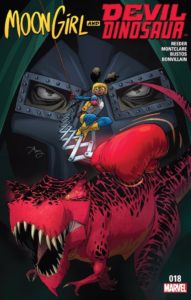 selling), with its Asgardian/Shi’ar war, various gods and Phoenix forces, and Xavier-School alum Quentin Quire combining in a fast-paced, universe-spanning tale that hits all the right notes. Moon Girl and Devil Dinosaur would seem to have a much more focused YA audience in mind, but as it hits its eighteenth issue, and ends its third arc, it’s done an amazing job of cementing its main character into the regular Marvel universe while crafting a fun, charming story that should be attractive to both older and younger readers (the last title that hit that sweet spot so exactly was the first year or two of Power Pack, back in the ’90s). Seriously, if you aren’t reading this, you’re missing one of the best comics on the stands right now; pick up this issue and see why. Hellcat‘s been less
selling), with its Asgardian/Shi’ar war, various gods and Phoenix forces, and Xavier-School alum Quentin Quire combining in a fast-paced, universe-spanning tale that hits all the right notes. Moon Girl and Devil Dinosaur would seem to have a much more focused YA audience in mind, but as it hits its eighteenth issue, and ends its third arc, it’s done an amazing job of cementing its main character into the regular Marvel universe while crafting a fun, charming story that should be attractive to both older and younger readers (the last title that hit that sweet spot so exactly was the first year or two of Power Pack, back in the ’90s). Seriously, if you aren’t reading this, you’re missing one of the best comics on the stands right now; pick up this issue and see why. Hellcat‘s been less 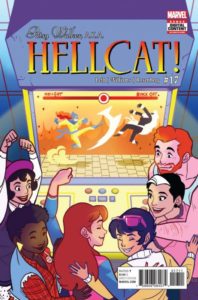 successful commercially (apparently, since this issue is its last…), but this finale, a coda and fond farewell to its cast, shows off the bright, cartoony girls’-club vibe that made it unique; a look at the letters page shows the kind of loyal, often-new-to-comics fans it created. At least it’s generated three cool trade collections (once the last one comes out in a few months) that, if there’s any justice, will be discovered and praised, giving this neglected little gem and its creative team the attention they deserve. Hulk has wanted to mine some of that same vein, but it’s been a much darker story, with a damaged Jen terrified of letting out her now-violent alter ego. At least, that’s what might be going on — five issues into a six-issue story, the actual Hulk has been nowhere to be found. I can see the temptation behind this as a story
successful commercially (apparently, since this issue is its last…), but this finale, a coda and fond farewell to its cast, shows off the bright, cartoony girls’-club vibe that made it unique; a look at the letters page shows the kind of loyal, often-new-to-comics fans it created. At least it’s generated three cool trade collections (once the last one comes out in a few months) that, if there’s any justice, will be discovered and praised, giving this neglected little gem and its creative team the attention they deserve. Hulk has wanted to mine some of that same vein, but it’s been a much darker story, with a damaged Jen terrified of letting out her now-violent alter ego. At least, that’s what might be going on — five issues into a six-issue story, the actual Hulk has been nowhere to be found. I can see the temptation behind this as a story 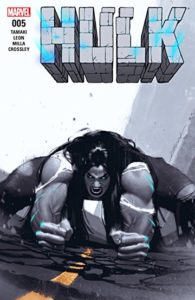 choice, but commercially it’s a disaster: if you call your book The Hulk, and put pictures of a Hulk on the cover, then readers who spend $20 to buy those first five issues, and get no Hulk, are naturally going to walk away, and even if your sixth issue is an awesome Hulked-out triumph, few people are going to see it. Too bad, because on its own terms this has been a decent, quietly-sad little story; it might work fine as a trade collection, where the payoff is immediate, but I’ll bet sales show it’s just not what a fan picking up an individual issue of a comic called The Hulk on the newsstand wants to see.
choice, but commercially it’s a disaster: if you call your book The Hulk, and put pictures of a Hulk on the cover, then readers who spend $20 to buy those first five issues, and get no Hulk, are naturally going to walk away, and even if your sixth issue is an awesome Hulked-out triumph, few people are going to see it. Too bad, because on its own terms this has been a decent, quietly-sad little story; it might work fine as a trade collection, where the payoff is immediate, but I’ll bet sales show it’s just not what a fan picking up an individual issue of a comic called The Hulk on the newsstand wants to see.
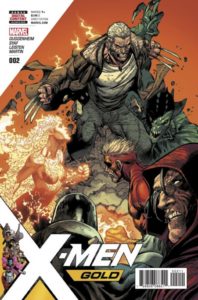 X-Men: Gold #2 — Writer: Marc Guggenheim; Pencils: Ardian Syaf; Inks: Jay Leisten; Colors: Frank Martin
X-Men: Gold #2 — Writer: Marc Guggenheim; Pencils: Ardian Syaf; Inks: Jay Leisten; Colors: Frank Martin
X-Men: Blue #2 — Writer: Cullen Bunn; Art: Jorge Molina; Colors: Matt Milla
Weapon X #2 — Writer: Greg Pak; Pencils: Greg Land; Inks: Jay Leisten; Colors: Frank D’Armata
Checking in on the sophomore issues of Marvel’s X-Men relaunch, we find things going about as expected: X-Men: Gold is the flagship title, with the “classic” ’70s/’80s X-team of Storm, Colossus, Nightcrawler, Kitty, Rachel and “a” Wolverine fighting a Brotherhood of Evil Mutants and a Trump-like rabble-rouser politician who wants to “deport” all mutants. That 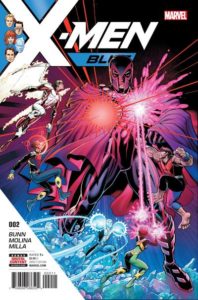 combination of super-hero fighting, soap-opera relationships and the whole “saving a world that hates and fears them” theme has worked well in the past, so it’ll be interesting to see if it still resonates with today’s audience. X-Men: Blue is both older and newer than Gold; it focuses on the “original” team, time-tossed teenage versions of Cyclops, Beast, Angel, Iceman and Marvel Girl, as they develop an uneasy alliance with Magneto and try to find their way in the modern Marvel world. The younger versions of the characters, their interwoven relationships, and the manga-ish tint to the art position this as more of a YA-friendly title than Gold, and we’ll have to see how the titles shake out in circulation and readership after their first dozen issues or so. Weapon X is more of an X-Force-like black-ops group than anything else — although, knowing what attracts readers, Marvel’s been careful to
combination of super-hero fighting, soap-opera relationships and the whole “saving a world that hates and fears them” theme has worked well in the past, so it’ll be interesting to see if it still resonates with today’s audience. X-Men: Blue is both older and newer than Gold; it focuses on the “original” team, time-tossed teenage versions of Cyclops, Beast, Angel, Iceman and Marvel Girl, as they develop an uneasy alliance with Magneto and try to find their way in the modern Marvel world. The younger versions of the characters, their interwoven relationships, and the manga-ish tint to the art position this as more of a YA-friendly title than Gold, and we’ll have to see how the titles shake out in circulation and readership after their first dozen issues or so. Weapon X is more of an X-Force-like black-ops group than anything else — although, knowing what attracts readers, Marvel’s been careful to 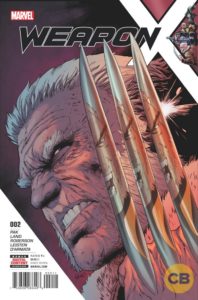 feature Wolverine prominently on its first two covers. These first few issues haven’t gotten too far into the premise yet; they’re still getting the band together, with a shadowy organization capturing James Proudstar while Wolverine and Sabertooth team up and bicker like an old married couple to avoid the same fate, and we’re told that Domino is the next target. Pak is an old pro at this sort of thing, so the pages turn smoothly, and the small character and action bits mesh together well; fans who’ve picked up the first two issues should have enough reason to keep reading, at least until this first arc is completed and we’ll know if it all works.
feature Wolverine prominently on its first two covers. These first few issues haven’t gotten too far into the premise yet; they’re still getting the band together, with a shadowy organization capturing James Proudstar while Wolverine and Sabertooth team up and bicker like an old married couple to avoid the same fate, and we’re told that Domino is the next target. Pak is an old pro at this sort of thing, so the pages turn smoothly, and the small character and action bits mesh together well; fans who’ve picked up the first two issues should have enough reason to keep reading, at least until this first arc is completed and we’ll know if it all works.
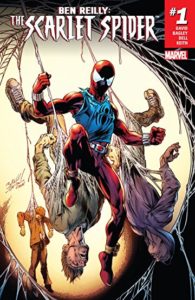 Ben Reilly: The Scarlet Spider #1 — Writer: Peter David; Pencils: Mark Bagley; Inks: John Dell; Colors: Jason Keith
Ben Reilly: The Scarlet Spider #1 — Writer: Peter David; Pencils: Mark Bagley; Inks: John Dell; Colors: Jason Keith
The Ultimates2 #6 — Writer: Al Ewing; Art: Travel Foreman; Colors: Matt Yachey
Black Panther #13 — Writer: Ta-Nehisi Coates; Art: Wilfredo Torres; Colors: Laura Martin and Andrew Crossley
Scarlet Spider #1 stems directly out of the Spider-Man Clone Conspiracy crossover from a month or two ago, as Ben Reilly, the Peter Parker clone who became the Jackal and caused so much angst in that series, now gets a solo book. That character’s got a tangled and off-putting history, especially for new readers, but Peter David’s got a knack for clear characterization and themes, so he’s a good choice to try to make both 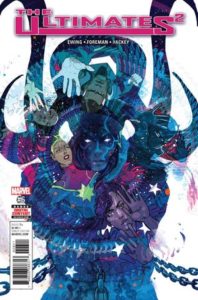 critical and commercial sense out of the material; Mark Bagley’s art is similarly mainstream-clear and inviting, so if any team can make this work, these two can (whether readers want yet another Spider-title without the “real” Peter Parker, no matter who’s creating it, is a question we’ll be able to answer in a few months…). Ultimates2 ends its first arc in fine fashion, with its glossy, high-concept cosmic plot (Eternity in chains! The origins of the “first” Marvel Universe! Zombie Galactus!) and powerful team combining in a pyrotechnic, satisfying resolution that keeps the door open for future developments. Artist Foremen and colorist Yachey are called upon to craft a number of complicated and wide-screen visuals here, and come through effectively and attractively; if you haven’t been buying this title, scrounge together these first six issues (or wait for the upcoming trade collection) and see if it isn’t one of the better comics on the stands right now, especially for old-time Marvel readers.
critical and commercial sense out of the material; Mark Bagley’s art is similarly mainstream-clear and inviting, so if any team can make this work, these two can (whether readers want yet another Spider-title without the “real” Peter Parker, no matter who’s creating it, is a question we’ll be able to answer in a few months…). Ultimates2 ends its first arc in fine fashion, with its glossy, high-concept cosmic plot (Eternity in chains! The origins of the “first” Marvel Universe! Zombie Galactus!) and powerful team combining in a pyrotechnic, satisfying resolution that keeps the door open for future developments. Artist Foremen and colorist Yachey are called upon to craft a number of complicated and wide-screen visuals here, and come through effectively and attractively; if you haven’t been buying this title, scrounge together these first six issues (or wait for the upcoming trade collection) and see if it isn’t one of the better comics on the stands right now, especially for old-time Marvel readers. 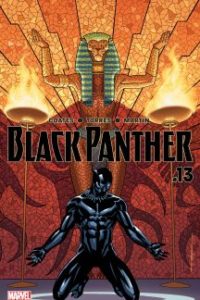 Black Panther starts its new arc with Coates having relaxed into his writing job well; the first twelve-issue story started out awfully talky, and had some complicated big political ideas that sometimes got in the way and slowed everything down, but here we start with an extended, fan-friendly Storm/Panther scene, then segue into an examination of the Wakandan gods — and their mysterious, and perhaps not entirely benign, motives — that lowballs its religious themes while simultaneously providing a lot of action and characterization: on-the-job learning, paying off.
Black Panther starts its new arc with Coates having relaxed into his writing job well; the first twelve-issue story started out awfully talky, and had some complicated big political ideas that sometimes got in the way and slowed everything down, but here we start with an extended, fan-friendly Storm/Panther scene, then segue into an examination of the Wakandan gods — and their mysterious, and perhaps not entirely benign, motives — that lowballs its religious themes while simultaneously providing a lot of action and characterization: on-the-job learning, paying off.
 The Flash #21 — Writer: Joshua Williamson; Art: Howard Porter; Colors: Hi-Fi
The Flash #21 — Writer: Joshua Williamson; Art: Howard Porter; Colors: Hi-Fi
Batman/Shadow #1 (of 6) — Writers: Scott Snyder and Steve Orlando; Art: Riley Rossmo; Colors: Ivan Plascencia
Batgirl #10 — Writer: Hope Larson; Pencils: Chris Wildgoose; Inks: Jon Lam; Colors: Deron Bennett
Hal Jordan and the Green Lantern Corps #19 — Writer: Robert Venditti; Pencils: V. Ken Marion; Inks: Dexter Vines; Colors: Dinei Ribeiro
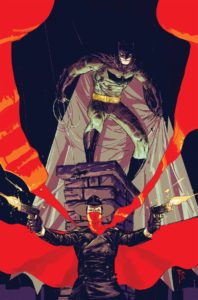 Kamandi Challenge #4 (of 12) — Writer: James Tynion IV; Art: Carlos D’Anda; Colors: Gabe Eltaeb
Kamandi Challenge #4 (of 12) — Writer: James Tynion IV; Art: Carlos D’Anda; Colors: Gabe Eltaeb
Doom Patrol #6 — Writer: Gerard Way; Pencils: Nick Derington; Inks: Tom Fowler; Colors: Tamra Bonvillain
This is another week where the DC books are more interesting, on balance, than the Marvel ones (a hard admission for a former Marvel zombie like me to make…). Flash #21 continues “The Button,” the four-part crossover with Batman about that bloody smiley-face artifact that we know so well from Watchmen. The first part, in Batman, saw the Reverse Flash 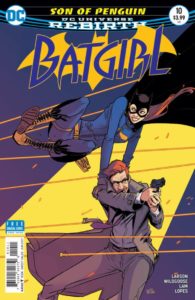 fighting the Caped Crusader and then “seeing God,” which didn’t end well for him; here, we get the ramifications of those events, plus a trip on the time treadmill, plus hints of the return of a bunch of very old-school legacy characters, plus an ending that will curve this nicely back to Batman next week. Between the “Superman Reborn” crossover last month and this tale, DC has proved adept at spinning out a meta-narrative that actually does affect its entire universe: this kind of thing, done well, is catnip to superhero fans, an indication that the company, after half a century of playing second fiddle, may be on its way back on top (now, if only they could do that for their movies…). Batman/Shadow is
fighting the Caped Crusader and then “seeing God,” which didn’t end well for him; here, we get the ramifications of those events, plus a trip on the time treadmill, plus hints of the return of a bunch of very old-school legacy characters, plus an ending that will curve this nicely back to Batman next week. Between the “Superman Reborn” crossover last month and this tale, DC has proved adept at spinning out a meta-narrative that actually does affect its entire universe: this kind of thing, done well, is catnip to superhero fans, an indication that the company, after half a century of playing second fiddle, may be on its way back on top (now, if only they could do that for their movies…). Batman/Shadow is 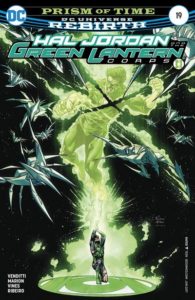 a six-part crossover that’s exactly as advertised, with a murder mystery involving the 1930s pulp character, and Batman trying to track him down and find out how he can still be alive and relatively young in a modern setting. With Scott Snyder co-producing the story, and art by Riley Rossmo (whose sleek, dramatic, pulp-influenced style is a good fit), there’s more than enough here to make this a success. Batgirl has settled into its new “Rebirth” era pretty much as in the previous one: she’s back in Burnside, has a modern-looking, just-a-little-cartoony art style, uses social media a lot, and is battling a new/old character: the son of the Penguin. It’s smoothly and entertainingly done,
a six-part crossover that’s exactly as advertised, with a murder mystery involving the 1930s pulp character, and Batman trying to track him down and find out how he can still be alive and relatively young in a modern setting. With Scott Snyder co-producing the story, and art by Riley Rossmo (whose sleek, dramatic, pulp-influenced style is a good fit), there’s more than enough here to make this a success. Batgirl has settled into its new “Rebirth” era pretty much as in the previous one: she’s back in Burnside, has a modern-looking, just-a-little-cartoony art style, uses social media a lot, and is battling a new/old character: the son of the Penguin. It’s smoothly and entertainingly done, 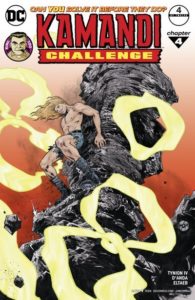 and if you’ve abandoned Barbara’s adventures at some point in the past, this is a good issue to check in on her and see if you might want to renew the relationship. Hal Jordan and the Green Lantern Corps is a similarly-smooth operation, with a similarly-smart idea of what its fans want: Hal, John, Kyle and Guy together with the alien GLs (and, right now, the Sinestro Corps) fighting galactic threats in space; as with Batgirl, if you haven’t been reading it for a while, it’s worth a look, because it might stir some fond memories. Kamandi Challenge has been getting by on its art so far, and this issue is no exception: D’Anda doesn’t have the cachet of a Neal Adams, or
and if you’ve abandoned Barbara’s adventures at some point in the past, this is a good issue to check in on her and see if you might want to renew the relationship. Hal Jordan and the Green Lantern Corps is a similarly-smooth operation, with a similarly-smart idea of what its fans want: Hal, John, Kyle and Guy together with the alien GLs (and, right now, the Sinestro Corps) fighting galactic threats in space; as with Batgirl, if you haven’t been reading it for a while, it’s worth a look, because it might stir some fond memories. Kamandi Challenge has been getting by on its art so far, and this issue is no exception: D’Anda doesn’t have the cachet of a Neal Adams, or 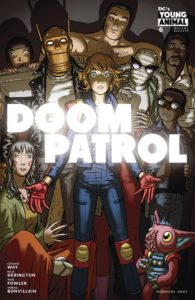 even an Amanda Connor, but he’s got a style that’s effective at making the anthropomorphic jaguars, kangaroos and other denizens of Kamandi’s world jump off the page; there’s also a writer’s-process essay by Jimmie Palmiotti about how he worked on the previous issue that’s worth reading. Doom Patrol, finally, ends its first arc with the team, both old and new, back together; its publishing schedule has been sporadic, but Way’s writing is a good match for the weirdness that’s always surrounded this book — and anybody who pays tribute to the 1990 Doom Patrol #30, the Crazy Jane origin issue that was one of the first indications that Grant Morrison was a great writer, is OK by me.
even an Amanda Connor, but he’s got a style that’s effective at making the anthropomorphic jaguars, kangaroos and other denizens of Kamandi’s world jump off the page; there’s also a writer’s-process essay by Jimmie Palmiotti about how he worked on the previous issue that’s worth reading. Doom Patrol, finally, ends its first arc with the team, both old and new, back together; its publishing schedule has been sporadic, but Way’s writing is a good match for the weirdness that’s always surrounded this book — and anybody who pays tribute to the 1990 Doom Patrol #30, the Crazy Jane origin issue that was one of the first indications that Grant Morrison was a great writer, is OK by me.
 Bitch Planet #10 — Writer: Kelly Sue DeConnick; Art: Valentine de Landro; Colors: Kelly Fitzpatrick
Bitch Planet #10 — Writer: Kelly Sue DeConnick; Art: Valentine de Landro; Colors: Kelly Fitzpatrick
Hillbilly #6 — Creator: Eric Powell
Lumberjanes #37 — Writers: Shannon Watters and Kat Leyh; Art: Ayme Sotuyo; Colors: Maarta Laiho
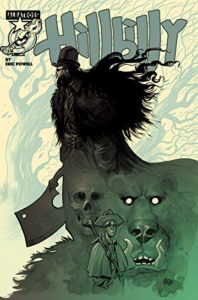 Kill or Be Killed #8 — Writer: Ed Brubaker; Art: Sean Phillips; Colors: Elizabeth Breitweiser
Kill or Be Killed #8 — Writer: Ed Brubaker; Art: Sean Phillips; Colors: Elizabeth Breitweiser
Rebels: These Free and Independent States #2 — Writer: Brian Wood; Art: Andrea Mutti; Colors: Lauren Affe
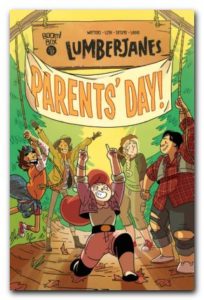 The Visitor: How and Why He Stayed #3 (of 5) — Story: Mike Mignola and Chris Roberson; Art: Paul Grist; Colors: Bill Crabtree
The Visitor: How and Why He Stayed #3 (of 5) — Story: Mike Mignola and Chris Roberson; Art: Paul Grist; Colors: Bill Crabtree
Stray Bullets: Sunshine and Roses #23 — Creator: David Lapham
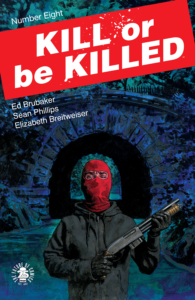 Rick and Morty #25 — Writer/Artist: Kyle Starks; Colors: Katy Farina
Rick and Morty #25 — Writer/Artist: Kyle Starks; Colors: Katy Farina
`Bitch Planet returns after an extended absence, as the story itself is peaking with a prison riot and revolution; it’s great, catching some of the same cultural zeitgeist as 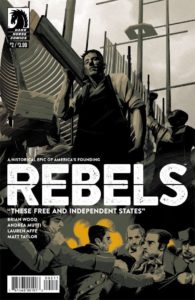 The Handmaid’s Tale, but it’s been so long you’ll probably have to reread the last couple of issues to really get the impact of some of the payoff scenes. Hillbilly continues to be Eric Powell doing Appalachian/Southern folklore as well as
The Handmaid’s Tale, but it’s been so long you’ll probably have to reread the last couple of issues to really get the impact of some of the payoff scenes. Hillbilly continues to be Eric Powell doing Appalachian/Southern folklore as well as  anybody on the planet; this done-in-one issue offers a very solidly built story with great creepy art. Lumberjanes starts an arc about Parents’ Day at the camp, as we get to meet everyone’s moms and/or dads; this offers bunches of clever, sympathetic characterization and its regular themes about friends,
anybody on the planet; this done-in-one issue offers a very solidly built story with great creepy art. Lumberjanes starts an arc about Parents’ Day at the camp, as we get to meet everyone’s moms and/or dads; this offers bunches of clever, sympathetic characterization and its regular themes about friends, 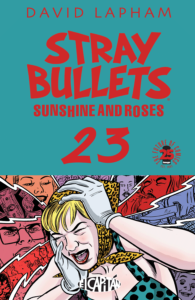 family and adventure, and anyone who’s going to miss Hellcat should pick it up right now. Kill or Be Killed is a good-guy serial-killer action thriller, confident and fun, while Rebels offers its usual well-researched look at, now, post-Revolutionary America (this issue begins in the shipyards of New York City in 1794), with some pointed
family and adventure, and anyone who’s going to miss Hellcat should pick it up right now. Kill or Be Killed is a good-guy serial-killer action thriller, confident and fun, while Rebels offers its usual well-researched look at, now, post-Revolutionary America (this issue begins in the shipyards of New York City in 1794), with some pointed 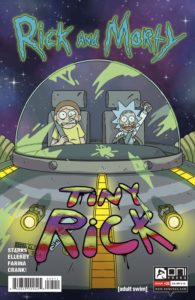 parallels to modern political divisions. The Visitor is insider-baseball Mignolaverse stuff (no Hellboy, unlike its first issue), enlivened by Paul Grist’s art (his angular style would be great on an Abe Sapien story…). Stray Bullets focuses on Beth’s mom, and wraps up a bunch of loose ends, some of them permanently, while Rick and Morty keeps matching the cartoon in its combination of cynical violent sf hijinx, high-school outcast angst and a hidden human heart (probably Morty’s, after an experiment of Rick’s gone awry, but still…).
parallels to modern political divisions. The Visitor is insider-baseball Mignolaverse stuff (no Hellboy, unlike its first issue), enlivened by Paul Grist’s art (his angular style would be great on an Abe Sapien story…). Stray Bullets focuses on Beth’s mom, and wraps up a bunch of loose ends, some of them permanently, while Rick and Morty keeps matching the cartoon in its combination of cynical violent sf hijinx, high-school outcast angst and a hidden human heart (probably Morty’s, after an experiment of Rick’s gone awry, but still…).



